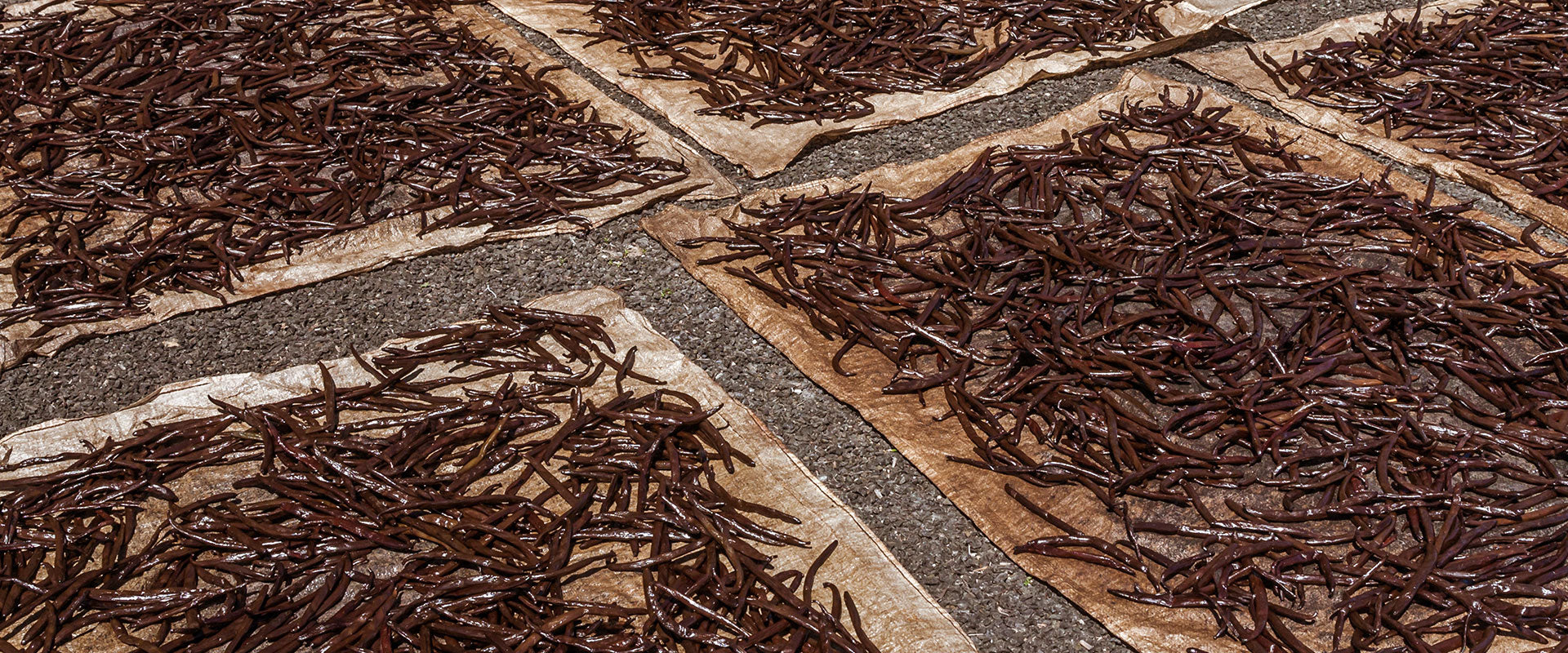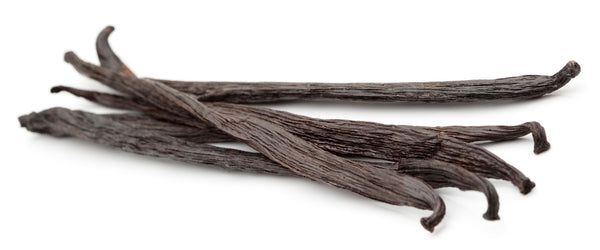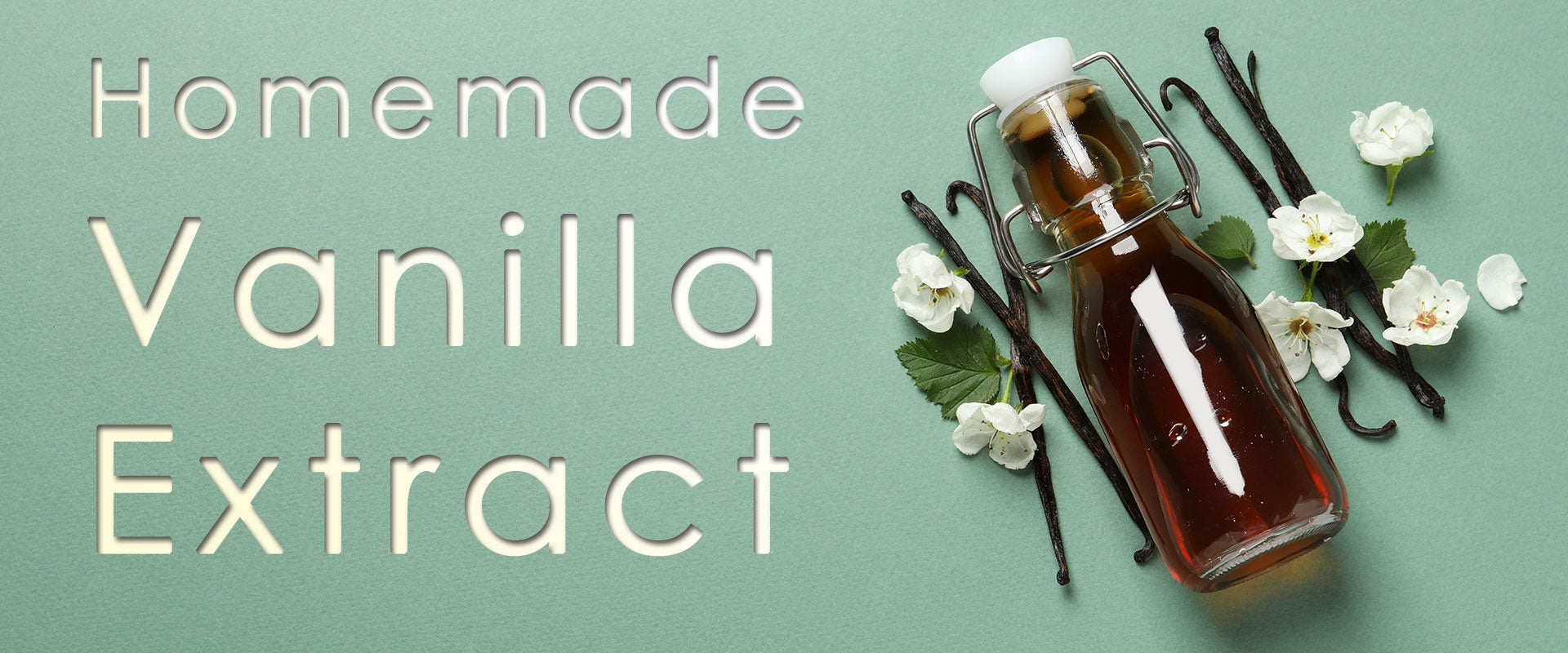How to Make Homemade Vanilla Extract Recipe
Authentic homemade vanilla extract offers bakers and chefs intense vibrant flavor that imitation vanilla can never touch. But what does it take to make a "good" homemade vanilla extract? You will need 3 things.
- Quality vanilla beans, and enough of them.
- Quality alcohol, and at the right strength (ABV).
- Contact time for a minimum of 30 days. Skip to [Recipe]
What Makes a "Good" Bean for Homemade Vanilla Extract?
Like all recipes, extracts reflect the quality of the ingredients you use to make them. If you use "Grade B" beans and cheap vodka, you will get "grade B extract" (at best), plain and simple. Begin by sourcing the best, highest quality vanilla beans you can find either locally or from a reputable online supplier of vanilla beans.
How to tell if your vanilla beans are "quality"?
First, read the reviews or ask the supplier questions on what to expect when the beans arrive, you might even get a free sample sent to you before ordering...
Upon inspecting your beans for the first time, trust your senses.
- How do the vanilla beans feel? High-quality vanilla beans are typically plump, moist, and slightly sticky when handled.
- How do the vanilla beans smell? High-quality whole vanilla beans should have a pungent and bold aroma. The more aroma the bean offers, the more flavor will be conveyed in your homemade vanilla extract.
Does Bean Variety (Madagascar, Uganda, ect) Matter?
Different varieties of vanilla beans will impart different subtle notes in the final vanilla extract, but so long as your beans pass the touch and smell test described above, any variety you choose (or have access to) will make a quality homemade vanilla extract. Read more: About Vanilla Bean Varieties for Homemade Vanilla Extract
What can I do if my vanilla beans don't pass the quality test?
Simple, supplement your recipe with more vanilla beans. Depending on the age and dryness of the bean, consider adding up to double the beans to get good final homemade extract. You can always weigh the beans you have too, and ensure that for every 8 fl oz of 100-proof alcohol solution, that you have at least 24 grams of vanilla beans.
Remember, "Quality in = Quality Out"

How Many Vanilla Beans do I (Really) need?
The US Food and Drug Administration (FDA.gov) provides guidelines for the minimum amount of vanilla contained within an extract to be labeled officially as "vanilla extract". These guidelines are provided to commercial manufacturers of vanilla extract for sale on grocery store shelves.
The FDA guidelines state that for every 1 liter (33.8 fl oz) of finished vanilla extract, no less than 100 grams (3.5 ounces) of vanilla beans must be used.
How Many Vanilla Beans is 100 Grams?
Depending on your variety and level of freshness, 1 vanilla bean weighs on average 4 grams or 25 beans per 100 grams. Therefore, to make 1 liter of authentic vanilla extract, you would soak 25 beans in 33 fl oz of 100 proof alcohol.
These guidelines are why I take issue with so many online recipes suggesting that you can just "keep adding alcohol" to your half-empty extract to magically get more extract! No...sorry...blog post coming on this topic shortly....
Vanilla Beans Per Fluid-Ounce of Finished Extract Table
1 liter of extract is over 200 teaspoons and might be more than most people want to keep on hand. If making small batches of homemade vanilla extract, use the table below for a quick reference on how many beans should to use for your homemade vanilla extract recipe.
| Vanilla Extract Final Batch Size | Yield (Teaspoons) | Count of Vanilla Beans Required | Vanilla Beans by Weight |
| 1 fl oz (30 ML) | 6 | 0.75 | 0.1 oz (3 grams) |
| 2 fl oz (60 ML) | 12 | 1.5 | 0.2 oz (6 grams) |
| 4 fl oz (118ML) | 24 | 3 | 0.4 oz (12 grams) |
| 8 fl oz (236 ML) | 48 | 6 | 0.8 oz (24 grams) |
| 16 fl oz (473 ML) | 96 | 12 | 1.7 oz (48 grams) |

On to the liquid: Choosing the Best Alcohol-to-Water Ratio (ABV) for Homemade Vanilla Extract Recipes.
Vanilla beans require both water and ethanol in solution for a complete extraction. The FDA guidelines for vanilla extract stipulate a minimum of 35% alcohol by volume ABV for final bottled extract. Any starting over 35% will make vanilla extract. We recommend using 50% ABV (100 proof) alcohol for your homemade vanilla extract recipe.
100 Proof (50% ABV) vs 80 Proof (40% ABV) for Homemade Vanilla Extract Recipes
There are many benefits to using a slightly higher ABV when making your vanilla extract including:
- Balanced & Complete Extraction of the water-soluble and alcohol-soluble compounds of the vanilla bean. Vanilla beans require both water and alcohol for a complete extraction.
- Enhanced Shelf Life. Alcohol in solution acts as a natural preservative by locking in the flavor compounds and aromatic oils, extending the shelf life of your extract to years, even when kept at room temperature.
- Accommodates the moisture present in the beans: Quality beans that are plump and slightly sticky will have a moisture content of up to 35%. Starting with an alcohol solution at 100 proof will accommodate for this added water brought by the vanilla beans ensuring the final ABV is never below 35%.
- Less Effect on Liquid Sensitive Recipes. Alcohol in extracts evaporates when exposed to air through stirring or mixing, or it vaporizes when cooked or heated. In contrast, water will first convert to steam. Extracts with a higher water content can affect the final recipe if too much is added to achieve the desired vanilla flavor. Even with a slightly higher alcohol concentration, there will not be an "alcohol taste," even in recipes that are not heated, such as ice cream or frosting.
Choosing the Right Alcohol for the Job
Not all alcohol is created equal. While crafting your own homemade vanilla extract, just as you select premium beans for optimal flavor and depth, the quality of the alcohol is equally critical. Culinary Solvent USDA Certified Organic food grade ethanol provides chefs and bakers with the highest quality ethyl alcohol for homemade vanilla extracts.
Vanilla Extract Preparation Notes
To Split, or Not-to-Split, the Beans
- Splitting the bean to expose the inner seeds of the pod is recommended, but not required for a complete extraction.
- Splitting the pod will allow the alcohol and water to reach the inner beans quicker, and will result in a faster extraction when compared to leaving the beans whole. Important to note, you won't get "more" of an extraction, just a faster extraction.
- Splitting the beans will result in some of the inner seeds falling out and settling on the bottom of your extract bottle, which may also result in them finding their way into your final recipe as little black specs. Generally, this is not a big problem for chefs as the black specs serve as notice to the consumer that real vanilla was used to achieve the flavor.
- If your beans are especially long, it is recommended to cut the beans in half or quarters to ensure that the beans are fully submerged in the alcohol water solution for best extraction results.
To Scrape, or Not-To-Scrape, the Beans
- Scraping the vanilla bean when making vanilla extract is unnecessary and not recommended.
- The bean pod contains vanilla flavoring components that contribute to the overall vanilla extract and should be included vs discarded.
- Scraping the inner seeds does fully expose them to the extract liquid, however also exposes them to air, creating the potential for some loss of flavor.
- Scraping the beans also can be messy, and you may lose some of the innards to the cutting board or knife.
TLDR: Splitting and scraping the vanilla beans before extraction is optional and will not positively affect the outcome of your finished homemade extract. There is a chance that splitting and scraping will reduce the overall vanilla flavor available to extract due to losses to the cutting board and atmosphere (fragrant volatile compounds)
Takeaway Recommendation: Split and Scrape?
Leave your beans whole for making vanilla extract and allocate enough time (14-30 days) for the extraction to take place.
If you are in a pinch for time, maybe you don't need an extract? Consider scraping the vanilla bean pulp directly into your recipe and skipping the extract step.
[Recipe] Steps for Homemade Vanilla Extract
Frequently Asked Questions for Homemade Vanilla Extract
How Long to Wait for Homemade Vanilla Extract to be Ready to Use?
Expect to let your vanilla extract sit for at least 30 days before being ready to use in your baking recipes.
What Does "Done" Look Like?
- Color - Finished vanilla extract will be dark brown to black. Tilted in the jar, the liquid should be more opaque than transparent. Amber translucent liquid after an infusing time of 30 days or more indicates that not enough beans were used in the recipe. (no need to start over, just add more beans and wait a bit longer)
- Aroma - The scent of the finished vanilla extract should be creamy, floral, and slightly sweet, with a hint of earthiness. The presence of alcohol in solution will be obvious, and depending on the fill level of your infusing vessel, more prominent if there is a lot of air space (ie if your jar is half full, the airspace in the jar will be mostly alcohol vapors). You can dissipate some of the alcohol vapors in jars with lots of airspace by gently blowing some air across the open container.
- Flavor - Sampling the vanilla extract directly is difficult to judge the vanilla flavor present thanks to the concentrated nature of the extract and the presence of the alcohol in solution. Instead, dilute a small amount of extract using a dropper into a medium like milk, cream, half-and-half, or simple syrup to get a gauge on just how much vanilla flavor is present in the extract. Suggested methods of sipping some milk plain, then sipping with extract added, then sipping plain milk again, then extract-added one last time will give your mouth and pallet the time to adjust to the nuance of baseline (plain) and flavor added to make a more accurate assessment of the infusion progression.

How to Store Finished Homemade Vanilla Extract
Follow these suggested best practices for optimal storage of your fresh homemade vanilla extract to maximize longevity and shelf-life of your creation.
Choosing a Storage Vessel for Homemade Vanilla Extract
Store finished vanilla extract in the same jar or bottle used for infusing. Keep the jar tightly sealed. Keep vanilla beans in the liquid as their flavor will continue to contribute to the liquid over a long period of time. The wide mouth opening makes it easy to dip a measuring spoon into the liquid for dispensing into recipes. Clear glass is fine for long term storage of vanilla extract, no need to source amber glass as is found on the store shelves.
Choosing a Storage Location Homemade Vanilla Extract
Cool and dark spot out of reach of children like a kitchen cupboard or refrigerator door. It is acceptable to store alcohol-based extracts over 35% ABV in the freezer, acceptable because the alcohol content will prevent freezing, however this step unnecessary for longevity. Extracts made below 35% ABV stored in the freezer may form a slush and is not recommended.
Estimated Shelf Life of Homemade Vanilla Extract
Use within 1-3 years. Vanilla extract does not expire (spoil), but over an extended period of time with frequent opening and closing, the flavors contained may begin to fade.
Consider Leaving the Beans in the Extract.
No need to separate vanilla beans from your finished homemade vanilla extract. There is no negative effect to leaving the beans in the extract for storage, and many believe that keeping the beans with the liquid continue to develop the flavor and depth of the extract. We recommend you keep the beans in the extract until the last drop is used.
Can you reuse vanilla beans to make more vanilla extract?
Many vanilla extract recipes online claim that once you deplete some of your finished vanilla extract, one may simply add more alcohol and water to the beans that remain in the jar, thereby creating even more extract. Well, sort of... Think in terms of coffee, if you brew a 2nd pot re-using grounds, you will get brown water sure, but the flavor is weak-at-best.
How can you tell if you have "weak" extract from reusing the beans?
It's just not easy to tell a vanilla extract's strength by taste and smell alone. We've all tried it, the smell is too irresistible to not dip a finger in a teaspoon of vanilla extract only to experience a bitter taste that no way resembles the aroma... The only way to tell if a vanilla extract is quality, is to make it yourself so that you know how much vanilla is in that extract. This practice of always making your own vanilla extract allows for greater consistency in recipe repetition and scalability too.
Recommended: Use Fresh Vanilla Beans Each Time You Make More Homemade Vanilla Extract
Vanilla beans contain only a finite amount of essential oils and flavor compounds that make them delicious, and simply adding more alcohol and water to a jar with used beans will result in a weaker extract than the first go. For the best flavor and consistent outcome, source new vanilla beans for each batch of vanilla extract you intend to make.
Can you Leave Old Beans from Past Extracts and Add New Beans on Top?
Certainly! Vanilla beans can sit in 50% alcohol solution for years without deteriorating into pulp, there is no harm keeping used beans in your infusion jar, so long as you continue to add fresh beans whenever making a new batch of homemade vanilla extract.
Even More Vanilla Extract Resources and Considerations
- "The Problem with Vanilla", Scientific American, September 2016, Link: https://www.scientificamerican.com/article/the-problem-with-vanilla/
- "Vanilla vs Vanillin - Science of Vanilla Flavorings" Foodcrumbles.com Blog, December 2021, Link: https://foodcrumbles.com/vanilla-vs-vanillin-vanilla-bean-ice-cream-recipe/












